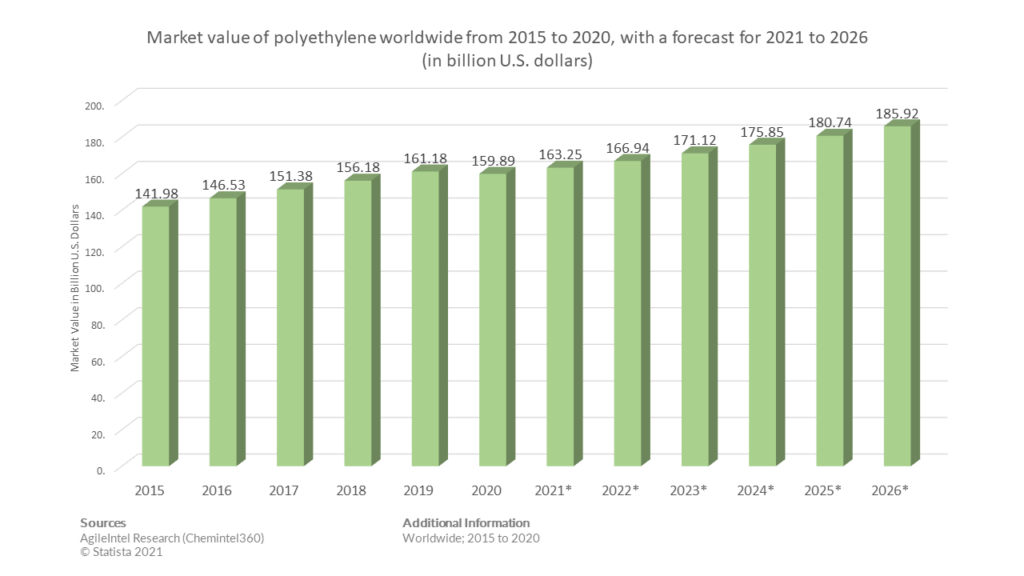The global market value of polyethylene worldwide was estimated to be around $141.98 billion U.S. dollars in 2015, and it is expected to grow significantly by the year 2026. The demand for thermoplastic polyethylene has increased rapidly due to its unique properties, such as chemical resistance, flexibility, and lightweight nature.
Polyethylene is one of the most common materials used by plastics factories in the world today, owing to its numerous applications in various industries, including packaging, construction, automotive, electronics, and more. Its versatility makes it an ideal material for manufacturing strong yet lightweight products; this helps reduce transportation costs and carbon footprint. There are also some early developments that show it might be possible to dispose PE plastic with the help of enzymes or even with worms directly. The growing demand for biodegradable plastics is also expected to drive the growth of the global market value of polyethylene worldwide. Here we will explore some insights related to the market value in the past and discuss the expected market value from the professionals in the future.
Global Market Value of Polyethylene World Wide from 2015 to 2021
The global market value of polyethylene has shown a consistent upward trend over the past few years. According to recent reports, in 2015, polyethylene had a market value of $141.98 billion worldwide. This number increased to $146.53 billion in 2016 and continued its upward trajectory in the following years.
In 2017, the global market value of polyethylene reached $151.38 billion, indicating an impressive growth rate of 3%. The subsequent year saw an even higher increase as the market value surged to $156.18 billion in 2018. These figures demonstrate that polyethylene is a precious commodity in today’s economy.
In 2019 polyethylene reached a market value of $161.18 billion in that year alone, indicating strong demand for this versatile material. This growth trend continued into 2020 with a market value of $159.89 billion.
Despite the challenges posed by the COVID-19 pandemic and other economic factors, the global market value of polyethylene is continuing to rise in 2021 by reaching $163.25 billion worldwide. Experts predict that this trend will continue well into the future as more industries adopt this versatile material for various applications.

Expected Value of the Market From 2023-2026 And Its Current Situation
The global demand for polyethylene, from plastic bags to plastic water bottles and pipes, continues to grow. According to industry reports, the market value of polyethylene is expected to reach $171.12 billion by 2023, rising from $166.94 billion in 2022.
With the increasing global population and industrialization, polyethylene demand has grown astonishingly over the years. In addition, new and innovative uses have been discovered for this material, which has only further increased its popularity across different sectors of the economy, including packaging, construction materials, and automotive parts, among others.
Looking ahead into 2024 and beyond, analysts are forecasting continued growth in the market value of polyethylene, reaching $180.74 billion. And in 2025, they predict that the market will reach $185.92 billion worldwide.
In Which Industry Does The PE Demand Gain Momentum?
Polyethylene is a highly versatile plastic that has become increasingly popular in various industries for various product and industrial designs. One of the reasons for its widespread use is its excellent rigidity and strength, which makes it ideal for applications that require durable materials. As a result, polyethylene demand has gained momentum in several sectors, including automotive, food & beverage, electronics, and consumer goods.
In the automotive industry, polyethylene is used to manufacture car interiors and exterior components such as bumpers and body panels. Its high resistance to impact and UV radiation makes it an ideal material for these applications. In addition, the use of polyethylene in electronic devices has also increased significantly due to its insulating properties and ability to withstand extreme temperatures. Similarly, the food & beverage industry has adopted polyethylene packaging due to its ability to keep products fresh while maintaining quality.
Polyethylene is also gaining momentum in the fashion apparel industry and the sports goods and toys segment. The growing demand for durable, flexible, and moldable materials is driving the popularity of polyethylene in these industries. Due to its resistance to water and chemicals, polyethylene is widely used to make various types of clothing, such as jackets, raincoats, and sportswear.
The packaging industry has also embraced polyethylene due to its excellent properties, such as flexibility and durability. Polyethylene bags are commonly used for packaging food items, electronics, and other consumer products. In addition to this, the sports goods industry has started using polyethylene-based materials in making balls for sports like soccer and basketball due to their lightweight nature.
Wrapping Up
The global market value of polyethylene worldwide has been on a steady growth trajectory since 2015, and all signs point to this trend continuing well into the future. The numbers don’t lie: the market value of polyethylene worldwide is in the billions of dollars and shows no signs of slowing down anytime soon. This is excellent news for both manufacturers and consumers alike. The forecast for the future of global polyethylene production looks very bright indeed, with experts predicting that it will only continue to grow as demand increases worldwide. As new technologies emerge that allow for even more efficient production methods, we can expect to see even more significant gains in efficiency and profitability across the industry. Recyclability of this material is also better than often claimed, according to the Washington Post. The sky seems to be the limit regarding what’s possible with this versatile material, so it’s an exciting time to be involved in this ever-expanding field!




